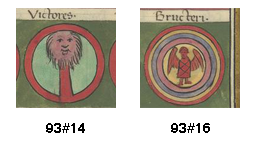
This page created 15 December 2015, and last modified: 115 December 2015

The 15th of the infantry units listed (102/5.68 in Ingo Maier's numbering scheme) in the Magister Peditum's Italian command is called the Victores seniores. No such unit is listed in the Magister Peditum's infantry roster, and no shield pattern labelled with such a name is shown.
It would appear that the entry for the Victores seniores has been deleted from the Magister Peditum's infantry roster (if it was there in the completed Notitia compilation as first compiled in the first place), as has any label accompanying a shield pattern; it is not so clear the pattern itself is absent (see further below).
Five other units in the Notitia incorporate the name "Victores":
Victores (98/9.38), a unit of auxilia palatina under the first Magister Militum Praesentalis,while two other units have very similar names:
Victores iuniores (98/9.60), a unit of auxilia palatina under the Comes "Hispenias",
Galli victores (98/9.89), a unit of auxilia palatina under the Magister Peditum's Italian command,
Honoriani victores (iuniores) (98/9.90), a unit of auxilia palatina under the Comes Illyricum, and the
Victores iuniores Britanniciani (102/5.206), under the Comes Britanniarum but not listed in the Magister Peditum's infantry roster, and which can thus also only be presumed to be a unit of auxilia palatina;
Cohors prima victorum (65.21), an auxiliary limitanei unit under the Dux Syriae et Eufratensis Syriae, andShield patterns labelled Victores and the Victores iuniores are preserved in the Notitia. They are not visually similar, but this is perhaps unsurprising given that pattern 93#14, labelled (93.o) Victores (iuniores), has evidently been mislabelled. The most likely pattern to have been borne by the Victores iuniores would appear to be that ascribed (93#16) to the Bructeri (98/9.62). The patterns are shown together below, using pictures taken from the Paris manuscript, P:
Ala prima Victoriae (67.14), a cavalry limitanei unit under theDux Osrhoenae.

That of 93#16, showing a winged Victory, would appear to be particularly appropriate for a unit named the Victores, meaning "victorious"; the word is also associated with Constantine I, who adopted the name "Victor" after defeating Licinius, in place of his former usage of "Invictus", after publicly espousing Christianity in place of the worship of Sol Invictus (the related form victrix was formally a common epithet for Roman military units).
The shield-label mismatch problem alluded to above may be intimately connected with the deletion of any entry for the Victores seniores from the Magister Peditum's infantry roster. The position of the Victores seniores in the Italian command list, between the Iovii seniores (102/5.67) and the Cornuti iuniores (102/5.69) implies the unit's position in the infantry roster, when (or if) present should similarly have come between the "Iovii seniores there (98/9.43) and the Cornuti iuniores (98/9.044): let is call this putative entry 98/9.43.1. Now it so happens that pattern 93#1 also features a winged Victory.

This shield pattern, labelled (93.a) Cornuti, would appear to have been misplaced one step, and thus belong to the Iovii seniores - if the Victores seniores is not inserted into position and given its pattern instead, that is. A winged Victory would suit a unit named Iovii seniores, since a winged Victory was one of Jupiter's most important attributes, but it would also obviously suit the Victores seniores at least as well.
Ammianus describes a unit of Victores as accompanying Theodosius on his British campaign in 367, but it is not clear which of the various Victores units listed in the Notitia (if any) this refers to, but the chances are the Victores seniores is meant, since the other units mentioned would appear to correspond to the western units the Batavi (seniores), Heruli (seniores), and the Iovii (seniores), forming a natural group.
1. Maier, Ingo; "Appendix 4: Numeration of the new edition of the compilation 'notitia dignitatum' (Cnd)"; last accessed 26 October 2015. See also for here for numbering examples. Return
2. Stephenson, Paul; "Constantine: Roman Emperor, Christian Victor"; Overlook Press, New York, 2010; at p 216. Return
3. "Ammianus" (Ammianus Marcellinus); "Res gestae a fine Corneli Taciti"; 27.8.7, available here in Latin and here in English (last accessed 16 December 2015). Return

Return to the Notitia alphabetical unit list page.
Return to my Notitia index page.